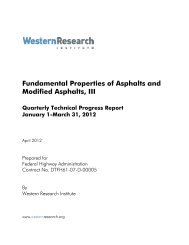Fundamental Properties of Asphalts and Modified Asphalts, III
Fundamental Properties of Asphalts and Modified Asphalts, III
Fundamental Properties of Asphalts and Modified Asphalts, III
Create successful ePaper yourself
Turn your PDF publications into a flip-book with our unique Google optimized e-Paper software.
Work Conducted This Quarter<br />
Introduction<br />
Both liquid-cell <strong>and</strong> photoacoustic (PA) infrared spectroscopy experiments are described for<br />
aged <strong>and</strong> unaged asphalt samples. In addition, aggregates <strong>and</strong> mixed aggregate-asphalt samples<br />
(mastics) are examined using PA spectroscopy. PA spectroscopy is unique in several ways to<br />
other more traditional infrared sampling techniques such as attenuated total reflectance (ATR).<br />
For example, the PA technique requires little sample preparation <strong>and</strong> has low sensitivity to<br />
surface condition [McClell<strong>and</strong> et al. 2002]. This is a very important concept that makes it<br />
possible to examine photo-oxidation <strong>of</strong> the pavement surface without use <strong>of</strong> solvents.<br />
Also, an evaluation <strong>of</strong> pavement distress at the FHWA/ WRI Arizona validation site <strong>and</strong> related<br />
rheological parameters is presented.<br />
Data presented here were collected under the <strong>Fundamental</strong> <strong>Properties</strong> <strong>of</strong> <strong>Asphalts</strong> <strong>and</strong> <strong>Modified</strong><br />
<strong>Asphalts</strong>, <strong>III</strong>, FHWA project (DTFH61-07-D-00005) <strong>and</strong> to a small extent under the Asphalt<br />
Surface Aging Prediction (ASAP) project (DTOS59-07-H-0006) for the Research <strong>and</strong> Innovative<br />
Technology Administration (RITA). The projects are complimentary in terms <strong>of</strong> achieving a<br />
better underst<strong>and</strong>ing <strong>of</strong> how asphalt pavement ages, but the ASAP project is specifically directed<br />
towards providing a tool <strong>and</strong> methodologies for determining the appropriate time for the<br />
preemptive application <strong>of</strong> rejuvenating surface treatments.<br />
Experimental<br />
Asphalt Aging<br />
Aging protocols, for this project, included the rolling-thin-film oven (RTFO, AASHTO T-240)<br />
method <strong>and</strong> the pressurized aging vessel (PAV, AASHTO R28) method.<br />
Rheology<br />
The complex shear modulus <strong>and</strong> phase angle <strong>of</strong> the original <strong>and</strong> laboratory aged asphalts were<br />
measured using a Rheometrics Model RDA II Dynamic Analyzer (a research-grade dynamic<br />
shear rheometer, DSR). DSR measurements for the SHRP asphalts were performed at 25˚C <strong>and</strong><br />
60˚C <strong>and</strong> a frequency range <strong>of</strong> 0.1 to 100 radians/sec at each temperature. DSR measurements<br />
for the Arizona validation site asphalts were performed at 10 degree intervals over a temperature<br />
range <strong>of</strong> 0 to 80°C <strong>and</strong> a frequency range <strong>of</strong> 0.1 to 100 radians/second.<br />
FTIR Instrument<br />
The infrared spectrometer used for this survey was a Perkin-Elmer Spectrum One ® equipped<br />
with a deuterated triglycine sulfate (DTGS) detector. The spectrometer was controlled by a<br />
desktop PC running Spectrum v5.0.1 s<strong>of</strong>tware. Available optical path difference (OPD)<br />
velocities were 0.1, 0.2, 0.5, 1.0 <strong>and</strong> 2.0 cm/sec.<br />
13





